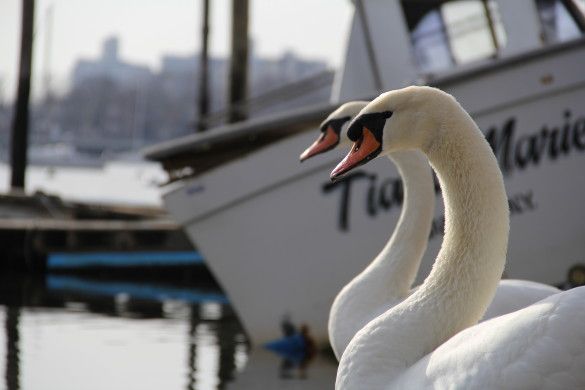On Webers Court, Where Swans And People Live Side-By-Side, Mute Swans Make “Good Neighbors”

Paige Strackman has lived for eight years in her home on Webers Court, a bungalow-lined private street off Emmons Avenue that ends in a sandy lump on the water’s edge. It’s a haven for the area’s mute swans, who live alongside their human neighbors in what may be the most intimate cohabitation between the waterfowl and city dwellers.
Strackman has come to regard the big white birds standing about or looking for food on the waterfront as a part of her community, where there is usually a group of 10 or more . But if the state gets its way, the birds will vanish from the landscape.
The state recently released plans to kill and remove all of New York State’s mute swans. According to a report released by the Department of Environmental Conservation (DEC), mute swans like the one in Strackman’s community are a problem. We recently summarized the department’s justifications:
- Swans destroy aquatic vegetation
- Swans can be aggressive towards people
- Swans are territorial, and displace native wildlife species
- Waste produced by swans can upset the chemical balance of waterways like Sheepshead Bay
Strackman doesn’t know anything about the plans, nor does she agree with the characterization of swans being aggressive or territorial.
“For us, they’re part of a landscape.” she said. “It seems like they’re a natural part of the environment.” But the DEC categorizes the swans as an “invasive species.”

While Strackman was talking about the swans, a landlord for an Emmons Avenue apartment attempted to herd a stray swan back to Webers Court and its sliver of beach head. The landlord, Peter, didn’t want to reveal his last name. As he led the swan away from the car-filled streets with bread, he explained that every so often swans get lost and end up on the avenue away from their group.
Aware of these dangers, Strackman said, “I worry more for their safety. It’s an urban environment and you have the cars that could hit them and then there’s the problem with polluted water.”
The DEC traces the swan’s history back to the late-1800s, when they first began to appear in North America. Since then the population boomed to more than 2,220 across the state. But 25 years ago, swans were not as common of a sight as they are today in Webers Court and Sheepshead Bay, according to Strackman’s neighbor, Cliff Bruckenstein.
“I don’t see them destroying anything,” said Bruckenstein, who has lived on Webers Court for 25 years. Bruckenstein went on to challenge the DEC’s claim that the mute swan can be bellicose. “They’re really not an aggressive species. They only get protective around their nests.”
Among the many things the department plans on doing if the plans aren’t altered is to kill and capture them, as we previously reported. If approved, the agency would conduct mute swan control on any accessible public or private lands in the state – including Webers Court and the Sheepshead Bay marina. Any swans removed will be euthanized. Nests will be destroyed, and eggs will be oiled or punctured.
“They want to kill a species that has been bred into [New York State],” Bruckenstein said in response to the plans. “I think it’s very much the wrong thing to do when there are many other things to do.”
“They’re no longer an invasive species,” he said. “They’re good neighbors.”
The Department for Environmental Conservation is taking comments on the draft plan. Deadline for comments is February 21. You can write to: NYSDEC Bureau of Wildlife, Swan Management Plan, 625 Broadway, Albany, NY 12233-4754 or by e-mail to fwwildlf@gw.dec.state.ny.us (please type “Swan Plan” in the subject line).



